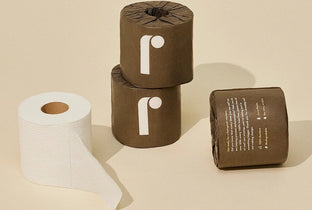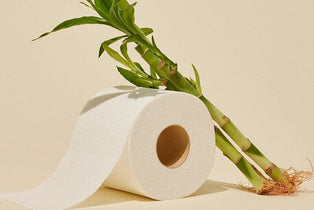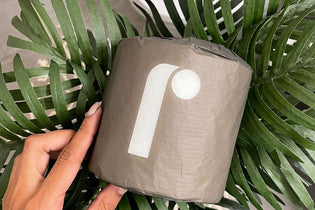
TLDR
2020 was certainly the year of toilet paper. Two years later, there seems to be more of a spotlight on the product and people are asking more questions about our reliance on toilet paper and its sustainability. That’s why paper alternatives, like bamboo toilet paper, have gained popularity as an eco-friendly solution to the growing demand for toilet paper.
From sourcing materials to disposing the product - what is toilet paper’s true impact on the planet?
Fortunately, almost all toilet paper is biodegradable as it is made from natural pulp fibers, but there are a lot of different factors that come into play.
We are going to take a look at all of this in this article and share a little information about the biodegradable toilet paper that you can find in almost every home.
Is toilet paper bad for the environment?
Traditional toilet paper that you find in most store aisles is made with virgin tree fibers, meaning trees are cut down to make this paper good specifically. The paper industry cuts old-growth trees (estimated tens of thousands per day) and releases stored carbon into the atmosphere to make toilet paper. This land use, along with toilet paper landfill waste, are both a serious source of concern as we look at the global fight against climate change.
To learn more about the problems with regular toilet paper, we recommend checking out the NRDC’s “The Issue With Tissue”. They cover the topic at great length and go into all of the specific concerns around most current toilet paper practices.
The reliance on toilet paper is not something that is going to change overnight, but there are sustainable alternatives available. Three of the most common alternative fibers to make toilet paper are recycled paper, bamboo, and bagasse.
1. Bamboo toilet paper
Bamboo toilet paper is made from - you guessed it - fast-growing bamboo, one of the fastest growing plants on the planet. How fast does a bamboo grow in a day? It depends on the different types of bamboo, but the average reaches full maturity in weeks. Many people confuse bamboo for a tree because of its size and nature, but it is actually grass and grows like it. The rapid growth in which bamboo grows, as well as its durability, makes it a great alternative to regular toilet paper. Bamboo toilet paper can keep up with the extreme demand that the growing population has for paper products.
2. Recycled toilet paper
Recycled toilet paper is another eco-friendly alternative that can help fight the deforestation caused by traditional paper products. Toilet paper made from recycled material can be found in many store aisles, but two things that you will want to keep an eye out for are whether or not it is BPA-free and the percentage of post-consumer fibers. BPA is a chemical that can find its way into recycled toilet paper due to the recycled paper that is used to make the product. The percentage of post-consumer fiber is letting you know what percent of the recycled material is made from paper that had been used previously - such as office paper or school paper
3. Bagasse
Bagasse is another popular alternative that is a creative use of a by-product from sugar production. It is a dry fiber that is left over after the juice is extracted from sugar cane and can be developed into a really great material for making paper products. It is often compared to bamboo in regards to how soft the final paper product can be and in many instances, the two fibers can be blended together to create a product.

Is recycled toilet paper biodegradable?
Recycled toilet paper is a more sustainable toilet paper than the traditional, but is it biodegradable as well? Yes, recycled toilet paper is biodegradable and is actually made from shorter fibers than traditional toilet paper, so it likely breaks down even quicker in certain circumstances.
Fiber length is one component of how quickly eco-friendly toilet paper will biodegrade, but a few others to keep in mind are - the type of fiber, the thickness of the toilet paper sheets, and what the toilet paper is exposed to.
All fibers act a little differently, but traditionally fibers made from sustainable or recycled materials tend to be a little shorter than virgin wood fibers. These shorter fibers allow them to break down a little quicker and start to biodegrade faster.
The thicker the tissue paper, you can normally assume the more it will take for it to biodegrade, regardless if it's in your septic system or landfill. This one is pretty straightforward as well - there is simply just more of it and takes longer.
Lastly - where is the biodegradable toilet paper going? Is it being flushed down a toilet, is it being flushed in an RV or is it being left out in the elements on a camping trip? All of these different scenarios will cause this sustainable toilet paper to break down in different ways.
Traditionally toilet paper that is flushed and processed in the water system can biodegrade in a couple of months. But it is commonly reported that toilet tissue that is left out in nature can take anywhere from 1-3 years to decompose completely. This is obviously a big range and certainly will vary depending on where you are - for example, if you are somewhere where there is a lot of rainfall such as a tropical rainforest, it will break down differently than somewhere where it is very dry.

Test how your toilet paper breaks down
One easy trick to test how easily your bathroom tissue breaks down and starts to biodegrade in water is the water bottle test. It is a relatively simple test that requires a couple of empty water bottles, some water, and the eco-friendly toilet paper you would like to test. Here are the steps:
- Simply fill the bottle with a little bit of water,
- Take a few pieces of toilet paper and fold them into a square.
- Load the square into a water bottle and let it absorb for a little while (30 seconds)
- After that give it a good shake a few times (around 5 shakes)
- Take a look and see how the toilet paper reacted to the test
- Let it sit for a few hours and come back and see how the toilet paper looks
From this test will be able to see how the toilet paper breaks apart in water and starts the process of decomposing.
At Reel Paper, you can find the best bamboo paper products for your at-home needs. Our bamboo toilet paper is not only sustainable, but also biodegradable. We also have bamboo paper towels, recycled paper towels, and eco friendly tissues, making sustainability even easier. You can make a change in the world with small changes like toilet paper you choose. Check out our eco-friendly products and bulk toilet paper today!




0 comments